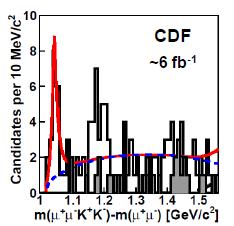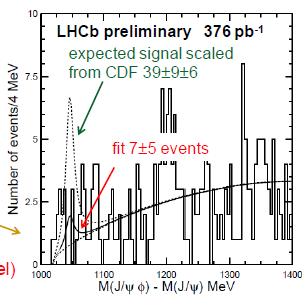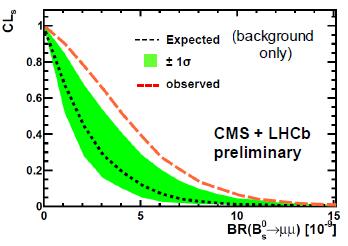Recent analyses in the B-physics sector by CDF produced a couple of important claims. I will not bother to tell you that I was extremely cold on both of them -I can offer circumstantiated proof in both cases, but the topic of this article is not my own (very good) nose for fake signals. Instead, I will just flash the two results and proceed to show how LHCb dismantled them.
 The first is the tentative observation ofa new hadron, called Y(4140), a bump observed in the invariant mass of pairs of muons and pairs of kaons. I will spare you the details, which you can find in the original preprint by CDF. The relevant figure is the one on the right, which shows the mass difference between the four-body system and the dimuon system. The signal is in red, the phase space is in blue.
The first is the tentative observation ofa new hadron, called Y(4140), a bump observed in the invariant mass of pairs of muons and pairs of kaons. I will spare you the details, which you can find in the original preprint by CDF. The relevant figure is the one on the right, which shows the mass difference between the four-body system and the dimuon system. The signal is in red, the phase space is in blue.Being unable to fit a reasonable phase-space model to the endpoint spectrum, CDF interpreted it as the signal of a new particle sitting near threshold, and called it Y(4140). The signal was allegedly evaluated as a 5-standard-deviation thing after more data was added to a previous analysis which had found a first 4-sigmaish evidence. I wrote about the matter in some detail here, keeping a rather sceptical attitude; however, since my opinion at the time could offend some of my collaborators, I wrote it in Greek in my greek blog... I think you can still make sense of my deep scepticism on the Y in the post if you dump it into translate.google.com. Here is the relevant part:
Δεδομένου ότι τα αποτελέσματα και των δύο αναλύσεων έχουν δημοσιευτεί, οποιοσδήποτε μπορεί να αφαιρέσει τα παλιά δεδομένα (αυτά που φαίνονται στο πλάι) από τα νέα, βρίσκοντας έτσι προς έκπληξή του ένα ενδιαφέρον αποτέλεσμα: το σήμα δεν είναι τόσο στιβαρό στα νέα δεδομένα.Όπως πάντα, οι πιο ανήσυχοι ανάμεσά μας θα πρέπει να περιμένουμε περισσότερα δεδομένα για να πιστούμε γι’ αυτό το σήμα
Have fun with google translate..
Also, in another post which was more didactical in nature I touched the subject tangentially, (and this time in English), but if you are interested in the issue please visit that article as well. Now LHCb looked for the same signature in the large sample of data they collected in 2011 (376 inverse picobarns, to be precise). What they see is shown on the left. They can only fit 7+-5 signal events -a null observation- and their data shows a difference of 2.4 standard deviations with the CDF result. Note that, as reported in the figure, if the CDF signal were as estimated by CDF, LHCb would have been able to fit 39+-9+-6 events. The Y(4140) is on very shaky ground at the moment, and the new PDG will likely change its status in the particle zoo... This is punch number 1.
Now LHCb looked for the same signature in the large sample of data they collected in 2011 (376 inverse picobarns, to be precise). What they see is shown on the left. They can only fit 7+-5 signal events -a null observation- and their data shows a difference of 2.4 standard deviations with the CDF result. Note that, as reported in the figure, if the CDF signal were as estimated by CDF, LHCb would have been able to fit 39+-9+-6 events. The Y(4140) is on very shaky ground at the moment, and the new PDG will likely change its status in the particle zoo... This is punch number 1.Punch number two came not just from LHCb, but from a combination of LHCb and CMS data. This concerns the never-ending search for decays of B_s mesons to muon pairs, a very rare decay mode which may be enhanced in Supersymmetric models. CDF very recently reported a signal and tentatively measured the branching fraction as 1.8E-8 -five times the SM prediction, a result strongly smelling of SUSY particles contributing in virtual loops!
 Now LHCb and CMS report that their combined limit on the branching fraction yield a probability that the BR is indeed what measured by CDF as 0.3% (the CDF measurement would be off the page in this graph, at "18" in 10^-9 units). The PDF of the branching fraction obtained in a combination of their results is shown on the right. Punch number 2.
Now LHCb and CMS report that their combined limit on the branching fraction yield a probability that the BR is indeed what measured by CDF as 0.3% (the CDF measurement would be off the page in this graph, at "18" in 10^-9 units). The PDF of the branching fraction obtained in a combination of their results is shown on the right. Punch number 2.I think it is rather unfair to pick two negative results to counter a positive one -this is a post-data practice which I cannot recommend. However, if we take every experimental input into account (not to mention my personal bias that the true BR of the B_s in dimuons is what the Standard Model predicts, and not five times more as some SUSY models would have it), we have to conclude that the CDF evidence of B_s decays is fading out.
So in the end: two CDF effects do not get confirmed. Neither is officially dead yet. Stay tuned for more!





Comments